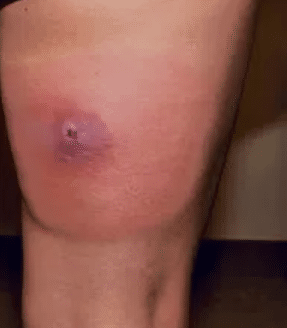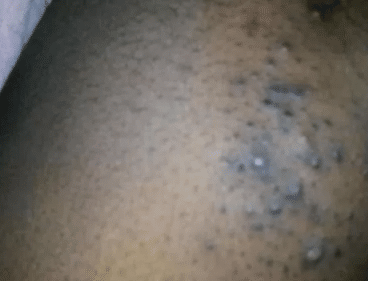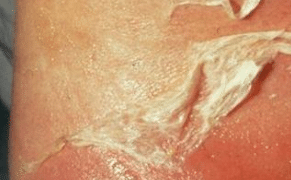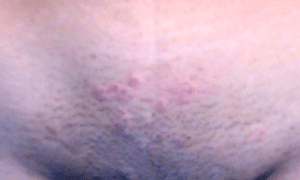Ingrown Hair
Ingrown Hair on Legs, How to Get Rid, on Thighs, Infected, Lots, Causes, after Waxing
on
What exactly are ingrown hairs? How do ingrown hairs look like? Get an overview on ingrown hairs in the below article. Also explained are causes of ingrown hairs on thighs, and legs after waxing.
Ingrown Hair on Legs
Ingrown hair is a very common skin condition occurring primarily in post pubertal individuals. An ingrown hair happens when sharp tip of the hair curls back or grows sideways into the skin. It is a benign condition, which usually appears as a small tan or sometimes pink pimple under skin.
Often, a small dark pinpoint, part of the underlying hair may be seen under the skin bump. In more extensive cases, multiple small red or pink little bumps around hair follicles may be seen on any skin area that has been frequently shaved, such as face, neck, armpit, legs and pubic region.
According to Earth clinic, Ingrown hair on legs is a condition that commonly affects individuals who are fond of shaving their legs. This is mostly common among women who practice leg hair removal. Any activity on the legs that cause hair to be broken off unevenly with a sharp tip can cause embedded hairs. In this case, shaving is the leading cause.
What causes Ingrown Hair on Legs?
Sex Hormones
According to Mayoclinic, some sex hormones predispose people to developing ingrown hair. High level of sex hormones will trigger excessive hair growth, which can contribute as one of the ingrown hairs causes.
Tattoo on legs
A fresh tattoo can cause ingrown hairs on the legs due to the scabs discharged from the healing tattoo that cover the pores. You need to seek the advice of the tattoo artist to deal with ingrown hairs on tattoo.
Epilating
According to doctors on WebMd.com, while epilating, ensure that you use a high end machines with several number of tweezers. Using machines wi th few tweezers will only cut thin hairs short and not from the root. This makes you repeat shaving over the area thus promoting ingrown hairs on the leg after epilating. If you cannot get good epilators just use a blade manually.
Dry skin
Dry skin simply blocks pores that should allow hair to grow outside the skin. This encourages them to grow black in and so keeping a moist skin by constant re-hydration is important.
Tight clothing
Tight clothing that make the skin moist and hold tight the skin, blocks the pores causing them to easily bend any hair on them. This increases chances of ingrown hair.
Waxing
Waxing removes hair from the roots thus leaving open and exposed pores. These pores can be easily blocked thus resulting into ingrown hair. It is important to administer good after care, after waxing.
Dead cells on the skin
According to earth clinic, Dead cells on the skin blocks hair from growing out of the skin pores. The thick layers of dead skin causing the new growing hair to curl back into the skin resulting in ingrown hair. Exfoliation helps in removing these dead cells on the skin.
Poor Shaving methods
When shaving, avoid shaving against the grain. Shaving against the grain will push some hair back into the skin especially when using a blunt razor, this result to ingrown hair in the legs. Try and shave along the grains to avoid ingrown hair on legs.
Dull or blunt blades
When shaving always avoid using blunt blades since they make you go over the same area over and over. This makes you to push hair in the pores. Once slide or a maximum of two is the best way and trick to shave and keep ingrown hair away.
Naturally thick curly hair
Individuals with thick hair, tend to have them remain in the skin instead of growing out wards. Curly hair on the skin has a tendency of growing back into the skin, causing deep ingrown hair.
People who have fine hair tend to suffer less episodes of ingrown hair since thin hair will penetrate the skin and grow without any problems.
Blockage of follicular openings
According to WebMD, people with poor hygiene are also likely to end up with ingrown hairs problem. These are caused by the accumulation of dirt on the skin that may block the openings of hair follicles. Failure to exfoliate your skin is likely to cause the formation of in-turn hairs because some hairs will find it difficult to penetrate and grow. This will force the hair follicle to grow sideways within the skin.
What does an Ingrown Hair on my Leg Look Like?
Ingrown hairs look very similar to acne but they are very different. They happen when hair refuses to grow out of the follicles in the normal course. The hair instead curls or winds sideways into its own follicle or into the tissue of the skin creating a host of problems. This is how an ingrown hair look like:
- The area is prone to itching
- Inflammatory conditions make the area raw and tender.
- Reddish bumps appear carpet bombing swathes of the skin.
- Tips of follicle will be transparent exposing the hair curled tightly inside.
- Whiteheads referred to as Milia represent pus filled follicles that are fighting infection.
- Shaving over the inflamed area only exacerbates pain and discomfort.
- Because of dilation of blood vessels close to uppermost layers, skin appears reddish in color.
- Repeat exfoliation by shaving breaks pores leaving skin to inversion by surface bacteria.
- A closer look will reveal the dark shadow of hair tightly curl up inside the follicular sac.
- Generally the area affected by hair growths will appear rough, reddish-hued and dry.
How to Get Rid of Ingrown Hair on Legs
Warm compress
- Use warm compress. This helps to soften the tissues around ingrown hair.
- Apply a warm or moist towel on the affected area.
- Do this repeatedly until the hair appears close enough to the surface of the skin.
After applying the warm compress and once the hair is closer to the surface of the skin, slowly pluck the hair with a point tipped tweezers, so that, the end of the ingrown hair appears above the skin.
Keep in mind that the aim is not to pluck the hair out because this is very painful. Always sanitize the tweezers with alcohol before using.
Milk and bread
Use of milk and out-of-date bread will work well especially on a looped ingrown hair.
- Take some milk and warm then dip a piece of bread in it.
- Place the bread on the area of the skin with the deep embedded hair and keep it there for around 2 minutes or until the bread cools.
- Repeat again for another 20 minutes
- Check keenly if the pores has opened up and if so, use a sterile needle to pull the loop out.
Apple cider vinegar
Vinegar is yet another key home ingredient you could use to deal with ingrown hairs. Here’s how to use apple cider vinegar to treat deep infected ingrown hairs.
- Put some vinegar in a bowl.
- Mix together some vinegar and hot water [keep the mixture warm].
- Dip a cloth into this mixture and lightly press it on the affected area.
- Dip the cloth in warm water in case it gets cold in the process and apply again to the affected area.
This method is always slow and it takes a longer time and so you may have to repeat it for at least a week. Soaking a cotton ball in apple cider vinegar and apply it on the affected area is also a remedy. Let your skin absorb it. Use lukewarm water to wash off the area. Use it two times a day.
Benzoyl peroxide
Use benzoyl peroxide as it is particularly good for those ingrown hairs which are filled with pus and sem like pimples.
- Apply it to the affected area several times during the day, for at least a week. In the course of trying this, remove all the dead skin around the affected area. This will cut the bump or swelling which will make it easier for the hair to glow out.
Baking soda
- Mix together one cup of water and one tablespoon of baking soda.
- Dip a cotton ball or a cloth into the solution and apply it on the affected area.
- Leave it for 5 minutes and wash it off using cold water.
- Repeat the above procedure two to three times in a day to achieve faster results.
Cucumber
The use of cucumber can be useful for this case as follow:
- Place a few slices of cucumber in a refrigerator, and after about half an hour.
- Gently rub the slices on the affected area.
- Alternatively, mash half and mix it with a third cup of milk.
- Refrigerate the mixture.
- Dip a cloth or cotton in the mixture and put it on the ingrown hair.
- After a few minutes, wash off with lukewarm water. Use the remedy twice a day, for a few days.
Sugar
Sugar can be used to remove and prevent ingrown hairs through exfoliation. It does so by getting rid of dead skin cells and pushing the curled hair out. To prepare an effective remedy:
- Mix a cup of jojoba oil with one cup of sugar.
- Add ten drops of tea tree oil and apply this mixture onto the affected area.
- Now scrub the area in a circular motion and then wash it off with warm water.
- Repeat this for two to four weeks or until the curled-back hair surfaces out.
Honey
Honey is a natural medicine that we use for various conditions and disease. It has both antibacterial and anti-inflammatory properties. Apply honey to the affected area and allow it dry. Then, wash it off with cold water.
Aspirin
Aspirin which is a painkiller that we use often in our homes is also a perfect remedy for this condition. It alleviates symptoms associated with ingrown hair inflammation and redness.
- Soak 2 aspirin tablets in 2 teaspoon of warm water.
- Add half teaspoon of honey to the paste.
- Apply it over the affected and let it stay for at least 20 minutes.
- Rinse with warm water and pat dry. Use it one or two times a week.
Coffee
- Mix together half cup of unused coffee grounds and one cup lukewarm water.
- Massage the mixture on the affected area for a few minutes in a circular motion.
- Moisturizer with aloe Vera gel. The acidic properties of coffee make it easy to expose the trapped hair.
Black tea bags
Black tea bags are also helpful. They have very high concentration of tannic acid which make the skin smooth and at the same time reduce inflammation and redness.
- Rub a warm teabag over the affected area for three minutes every day, for several consecutive days.
- Alternatively, you can keep the tea bag in water for some time and then remove all the excess water from it, into a bowl.
- Add one teaspoon of coconut water to this tea water.
- Dip a cotton ball into the mixture, and then place t onto the affected area. Repeat this twice a day until you see the desired change on your skin.
Aloe Vera gel
Use pure aloe Vera and rub on the skin. Let it dry then rinse it off with warm water. Repeat two to three times in a day, for at least a week.
Tea Tree oil
Tea tree oil helps reduce swelling and redness caused by infected hairs. On a piece of cotton wool, dab a few drops of tea tree oil and keep it on the area of the ingrown bump and hair. The oil will facilitate the hair come out from beneath the skin and prevent further growth on the infected follicle. Better still, add a few drops to your body wash and use it clean your body.
Salt
Salt is also an appropriate remedy as it not only helps in exfoliation, but also increases blood circulation to aid ingrown hair come out. Here is how to use salt to get rid of deep ingrown hair shafts.
- Take one and half of salt and mix it with one cup of warm water.
- Dip a cotton ball into this solution and dab it on the affected area. Be careful not to wipe it off.
The most ideal time to do this would be before going to bed, so that that the salt can exfoliate and cleanse the skin overnight. Carrying out this process repeatedly on a daily basis helps attain the best results.
Apply hydrocortisone cream
Apply one percent hydrocortisone cream to the affected area. This according to Merck Manual, can be done two to three times daily, depending with the package directions. Hydrocortisone cream helps to reduce inflammation, which will make it possible to remove the ingrown end of the hair.
Use over-the counter-antibiotics
Treat the hair bump area for infection after you have removed the ingrown hair tip. Bacitracin and triple antibiotic ointment are usually the over the counter topical antibiotics available. It is also advisable that you contact your doctor for stronger antibiotic, if needed.
Ingrown Hair on Thighs Male
Men who opt to remove hair from their legs and thighs are likely to suffer from ingrown hairs. According to DR. Heidi Gilchrist, on www.healthtap.com a dime size lump on the thigh area, could be lipoma [ a benign growth of fat cells] in its earliest stages of development. He also opine that it could be skin cancer below the surface of your skin. You should see your dermatologist for an evaluation and possibly a biospsy.
Ingrown Hair on Legs after Waxing
Waxing and epilating normally pulls hairs directly from the root. As the hair is pulled very quickly, the follicle is badly damaged. The process then damages a small tube that every hair follicle is connected to it. This tube is normally responsible for guiding the hair to the surface when it grows back. If the lining of the tube is damaged during the hair removal, the new hair’s journey to the surface may not be very smooth.
Infected Ingrown Hair on Leg
According to Better Health Fast, Infected ingrown hairs occur when there are too many dead skin cells on the surface of the skin. These cells can inadvertently clog up the hair follicles. Infected Ingrown hairs are most common in areas of hair removal such as leg, armpits and public region. They also occur more often in men who shave their beards. Shaving and waxing creates sharper hairs that tend to get trapped in the skin.
You may also be at an increased risk for ingrown hairs and related infections if your hair on the leg is naturally curly. These hairs types are more likely to curl back into the skin when growing out after hair removal.
Often times, an infection of an ingrown hair can start off as a red bump. As the infection progresses, you may see pus and the bump may grow larger.
The area around the infected ingrown hairs may also:
- Appear red and irritated
- Swell
- Itch
- Feel warm to touch.
Further References:













